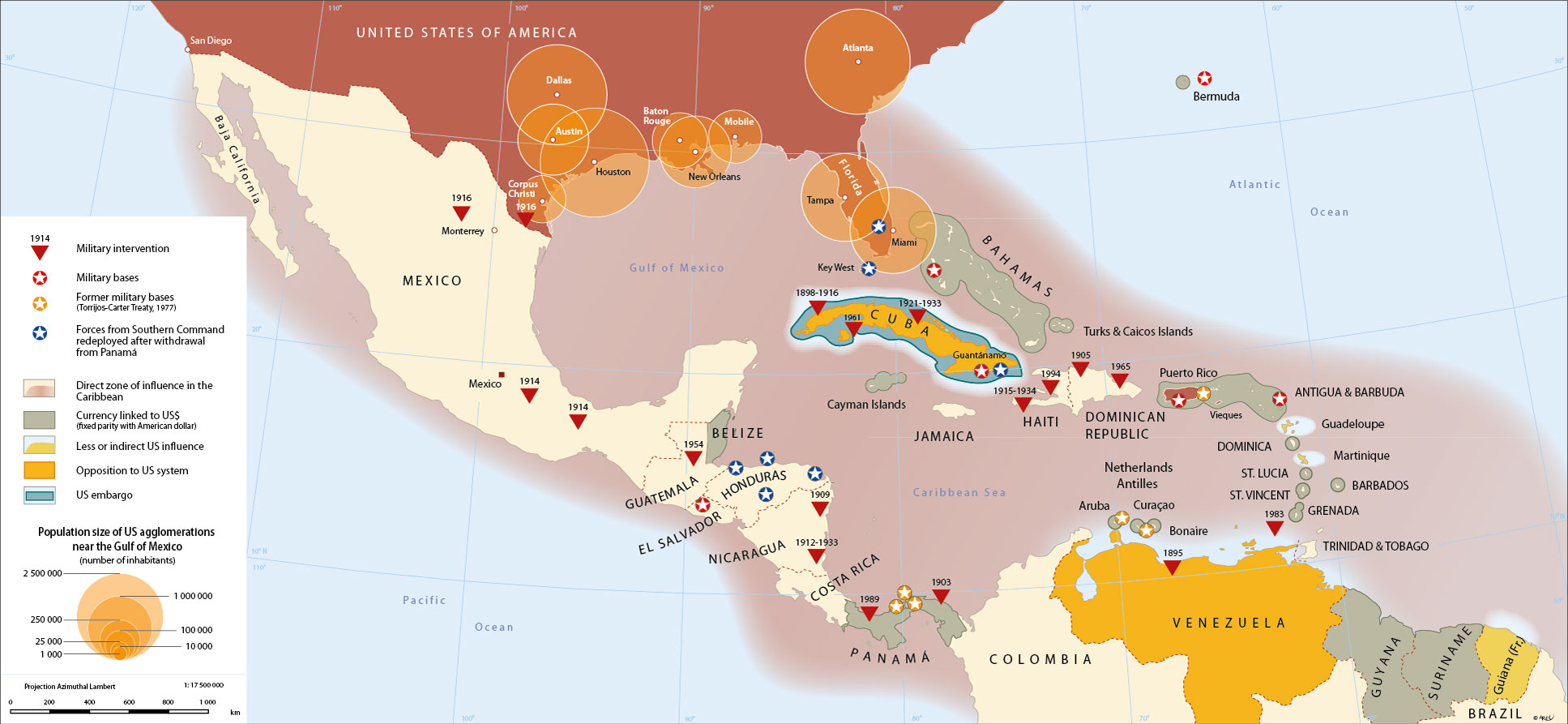
- AEC et crise mondiale (2012) FR
- Abolitions of slavery
- Armées (2005) FR ES
- Armées (2015) FR ES
- Backyard of the United States
- Carribean Basin and global economic crisis (2008)
- Eric William's Pan-caribbeanism
- Essequibo : territoire "réclamé", territoire convoité FR
- Europe in the Caribbean (2007)
- Géopolitique de la Guyane FR ES
- Géopolitique de la Martinique et de la Guadeloupe FR ES
- Independence
- Les frontières FR ES
- Les processus de «réincorporation nationale» et de créolisation FR ES
- Mosaïque institutionnelle (2015) FR ES
- Mosquitia protectorado Inglés en colonias “independizadas” ES FR
- Political status (2012)
- Rapprochement Cuba - Etats-Unis FR
- Statuts et carte politique (années 1990) FR
- Tensions ethniques FR ES
With all its overwhelming power, the United States' presence bears down on a politically and economically fragile Caribbean, without real resistance or competition.
Since the affirmation of their influence in the 19th century, varying constructions of American policy (Monroe Doctrine, Panamericanism) have viewed the Caribbean as a private hunting ground. The war with Spain (1898) inaugurated a long period of meddling and interventions, sometimes brutal, other times more discrete, intended to install, reestablish or reinforce the American presence in the region. Since the beginning of the 20th century, the United States have made and unmade, the governments of weak states in Central America in order to safeguard the interests of their multinationals. The Cold War saw their interventionism further reinforced: so in 1954 they were actively involved in Guatemala with the removal of Colonel Arbenz who had launched a massive programme of agrarian reform to the detriment of the all powerful United Fruit Company. In 1983, in Grenada, then in 1993, in Panama, they did not hesitate to intervene militarily. The erasing of European power in the region left the field clear, “Poor Caribbean, so far from God and so near to the United States,” to paraphrase the Mexican president Diaz.
The Cuban revolution in 1959 suddenly pushed the Caribbean to the top of the American agenda; with the missile crisis in 1962, it was the setting for the last, and one of the most dangerous, episodes of the Cold War. Since the ‘détente' and the disappearance of the ‘eastern bloc,' the ideological and military stakes in the region have markedly lessened. Nevertheless, the United States keeps an attentive watch on the Caribbean. A point of transit for a major share of the drugs traffic supplying the north American market (40% of cocaine passes via the islands route), it is also the route by which important flows of clandestine immigrants (particularly Haitians and Cubans) seek entry to the United States, as well being used for contraband goods from south-east Asia.
Thus in every domain of regional life, the United States have become the dominant player. Physically present by virtue of its five southern states, but also through the associated state of Puerto Rico as well as their dependencies (US Virgin Islands), they maintain an important military contingent within the region (the Guantanamo base in Cuba, bases in Panama until the end of 1999). The US dollar appears de facto to be the principal currency used in the region; in turn, their multinationals are omnipresent, especially in Central America which offers greater potential for agriculture and mining, than do the islands. They keep a direct watch on developments in Haiti, work unrelentingly against Cuba (Helms Burton Act), and through applied pressure, have obtained the right to intervene against drug traffickers in the sea and air-lanes of several ‘independent' states.
The Caribbean Basin Initiative (CBI) launched in 1982 by president Ronald Reagan, the North American Free Trade Agreement (NAFTA), the re-launch in 1994 by Bill Clinton of the Free Trade Area of the Americas (FTAA) project, and its follow-up by the Bush administration, all tend towards an even greater integration of the region within a vast organizational space dominated by the United States. By reinforcing regional solidarities and developing links with other partners (Europe), the countries of the region seek to escape from an overly exclusive and unequal ‘tête-á-tête.'
top
|
  |













